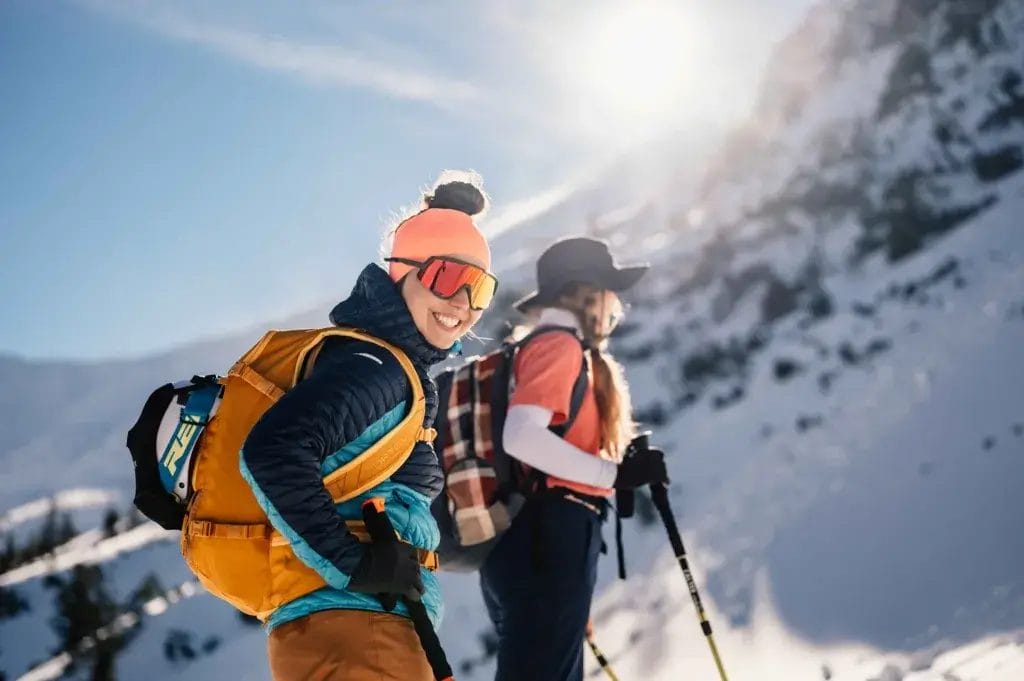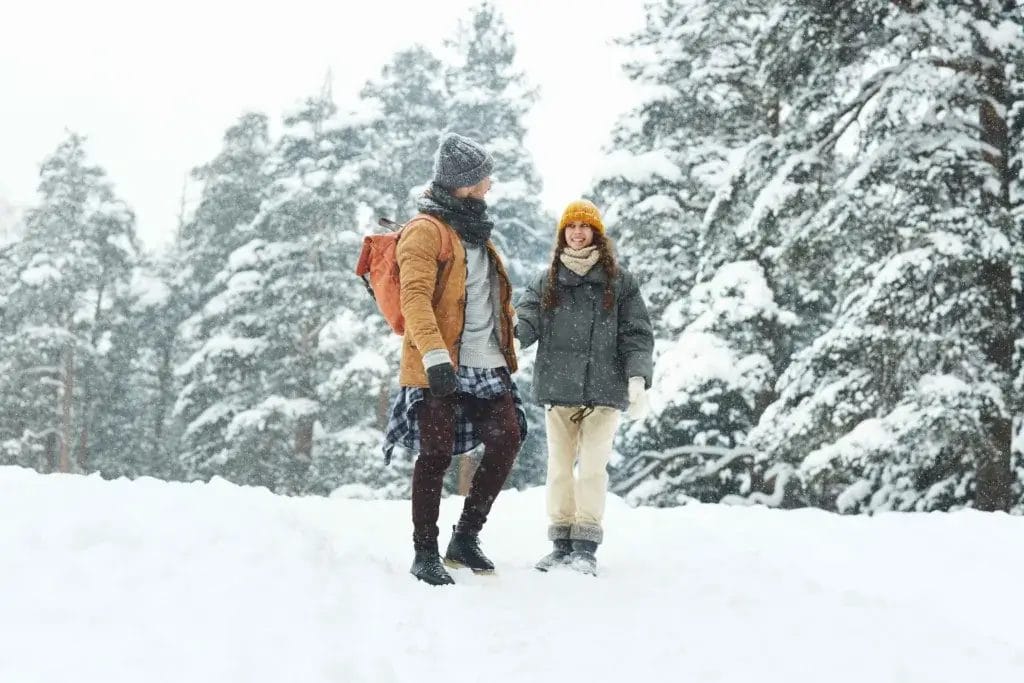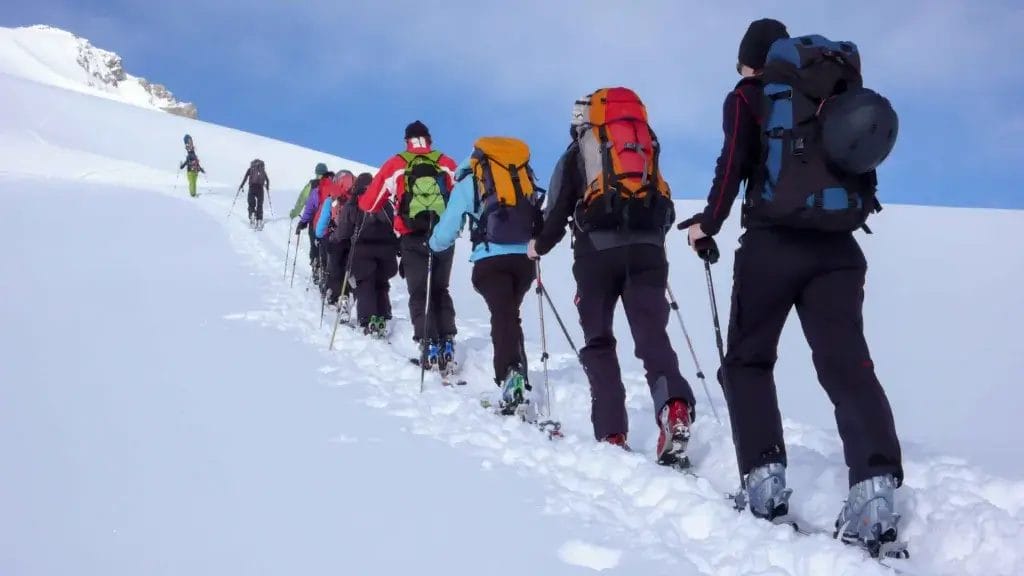Winter Hiking Layers: Stay Cozy on Chilly Trails
Winter hiking offers a chance to enjoy nature’s quiet beauty. But staying warm and dry can be tricky.
The key is to use layers that work together to keep you comfortable. A good layering system lets you adjust to changing conditions and activity levels as you hike.

We’ll show you how to pick the right layers for winter hiking. You’ll learn about base layers that wick sweat, insulating mid-layers, and outer shells that block wind and rain. We’ll also cover smart ways to use your layers on the trail.
With the right layers, you can stay cozy even when it’s cold outside. Winter hiking doesn’t have to mean being chilly or wet. Let’s explore how to dress for winter adventures so you can enjoy the outdoors all year round.
Key Takeaways
- Layer clothes to manage sweat and stay warm while winter hiking
- Use a wicking base layer, insulating mid-layer, and protective outer shell
- Adjust layers as you hike to stay comfortable in changing conditions
Understanding Layering Basics
Layering is key for staying warm and dry while winter hiking. We’ll explore why it’s important, how to adjust for different conditions, and what materials work best.
The Importance of Layering
Layering helps us manage sweat and stay comfortable in changing weather. A good layering system lets us add or remove clothes as needed.
The base layer sits next to our skin. It should be snug and wick sweat away. This keeps us dry and warm.
A mid layer traps heat. We can use fleece or wool here. These materials stay warm even if they get damp.
The outer layer blocks wind and rain. It should be breathable too. This stops moisture from building up inside.
Layering for Weather Conditions
We need to think about temperature, wind, and activity level when choosing layers.
For cold, dry days, we might wear a thick base layer and a puffy jacket. If it’s windy, we’ll add a shell on top.
When it’s warmer or we’re working hard, we’ll use thinner layers. This lets us cool off easily.
Rain calls for a waterproof outer layer. But we still need breathable layers underneath.
Materials and Fabric Choices
Synthetic fabrics like polyester are great for base layers. They dry fast and wick sweat well.
Wool is another good choice. It’s warm even when wet and doesn’t hold odors.
For mid layers, we like fleece. It’s light, warm, and dries quickly.
Our outer layer should be waterproof and breathable. Materials like Gore-Tex work well here.
We avoid cotton for winter hiking. It soaks up sweat and takes forever to dry.
Essential Layers Explained
Wearing the right layers is key for staying warm and dry while winter hiking. We’ll explore the three main layers you need and how to choose them wisely.
Base Layer Selection
The base layer sits next to your skin and helps manage moisture. We recommend moisture-wicking fabrics like merino wool or synthetic materials. These pull sweat away from your body to keep you dry.
Merino wool is great because it:
- Resists odors naturally
- Keeps you warm even when damp
- Feels soft against the skin
Synthetic baselayers are also good options. They:
- Dry quickly
- Cost less than wool
- Last a long time
Avoid cotton for your base layer. It holds onto moisture and can make you cold.
Choose a weight based on the temperature. Lightweight for mild days, midweight for cold, and heavyweight for very cold conditions.
Mid-Layer Options
The mid-layer traps warm air to insulate you. Fleece is a popular choice for this layer. It’s:
- Lightweight
- Quick-drying
- Breathable
We also like wool sweaters or synthetic insulated jackets. These work well as mid-layers too.
For very cold hikes, you might want two mid-layers:
- A thin fleece or wool layer
- A puffy insulated jacket on top
Adjust your mid-layers as you hike. Take one off if you get too warm. Add one during rest stops to stay cozy.
Outer Layer Protection
The outer layer shields you from wind, rain, and snow. A good hardshell jacket is key. Look for these features:
- Waterproof and breathable fabric
- Sealed seams
- Adjustable hood
- Pit zips for venting
Softshell jackets can work for dry, windy days. They’re more breathable but less waterproof.
Don’t forget waterproof pants for your legs. They keep you dry in deep snow or rain.
Choose bright colors for your outer layer. This helps others see you in bad weather.
Footwear and Sock Strategies
Keeping our feet warm and dry is key for winter hiking comfort. Good boots and socks make all the difference when trekking through snow and ice.
Choosing the Right Winter Hiking Boots
Winter hiking boots need to be tough and warm. We look for waterproof boots with good insulation. A thick sole helps keep our feet off the cold ground.
Ankle support is a must on uneven snowy trails. We make sure our boots fit well with thick socks. A roomy toe box lets us wiggle our toes to stay warm.
Gaiters are great add-ons. They keep snow out of our boots and our pants dry. We pick gaiters that are easy to put on and take off.
The Role of Socks in Comfort and Warmth
Layering socks can really boost warmth. We start with a thin liner sock to wick sweat away. Then we add a thicker wool sock for insulation.
Wool is our go-to material for hiking socks. It keeps us warm even when damp. We avoid cotton socks as they get cold when wet.
We always pack extra socks. Changing into dry socks midday feels great and helps prevent blisters. At night, we sleep in clean, dry socks to keep our toes toasty.
Accessorizing for the Cold

When hiking in winter, the right accessories can make a big difference in comfort and safety. Let’s look at some key items to protect your head, hands, and eyes from harsh conditions.
Hats and Neck Gaiters for Warmth
We love using warm hats to keep our heads cozy on cold hikes. A good winter hat should cover your ears and be made of insulating materials like wool or fleece.
Neck gaiters are super versatile. We can pull them up to cover our necks, chins, and even noses when the wind picks up. They’re great for trapping heat and blocking wind.
Buffs are another option we like. These tube-shaped accessories can be worn in many ways – as a hat, neck warmer, or face mask. They’re lightweight and easy to adjust as temperatures change during our hike.
Choosing Gloves and Hand Protection
Our hands need extra care in cold weather. We recommend bringing two pairs of gloves:
- A thin liner pair for dexterity
- A thicker, insulated pair for extreme cold
Waterproof gloves are great if we expect wet conditions. For very cold days, mittens can be warmer than gloves. Some hikers like glove liners with mittens over top for the best of both worlds.
Remember to pack extra gloves. Wet hands can get cold fast, so it’s nice to have a dry pair ready.
Eye Protection Against the Elements
We always protect our eyes when hiking in winter. The sun can be extra bright when it reflects off snow, and the wind can be harsh.
Sunglasses are a must on sunny days. We look for ones that wrap around to block side glare. For snowy or windy conditions, goggles offer more coverage and protection.
If we’re hiking in falling snow or very cold temps, goggles help keep our eyes from watering and eyelashes from freezing. Some goggles even fit over regular glasses, which is handy.
Safety and Protection

Winter hiking requires extra care to stay safe. We need to guard against cold-related dangers and make sure we can find our way in snowy conditions.
Preventing Hypothermia and Frostbite
Hypothermia and frostbite are serious risks when hiking in cold weather. We can prevent hypothermia by dressing in layers and staying dry. A good winter layering system includes a moisture-wicking base layer, insulating mid-layers, and a waterproof outer shell.
We should take breaks in sheltered spots and change out of sweaty clothes. It’s important to stay hydrated and eat high-energy snacks to keep our body temperature up.
For frostbite prevention, we need to cover all exposed skin. Warm mittens are better than gloves. We should wiggle our toes and fingers often to keep blood flowing.
Navigational Aids for Winter Hiking
Finding our way gets trickier in winter when snow covers trails. We always bring a map and compass, but a GPS device can be really helpful too.
A headlamp is essential since days are shorter in winter. We make sure to pack extra batteries, as cold drains them faster.
Bright colored clothing helps us stay visible in white-out conditions. We should let someone know our planned route and expected return time before heading out.
Trekking poles can help us check snow depth and stability. In avalanche-prone areas, we need proper training and safety gear like beacons and probes.
Advanced Layering Techniques

Let’s explore some expert strategies for staying comfortable in cold weather. We’ll look at how to adjust layers during different activity levels and changing conditions.
Layering for Active and Rest Periods
When we’re moving, our bodies generate heat. We need to be ready to shed layers quickly. Thin layers work great for this. We can easily take off or add a light fleece or shirt as needed.
For rest breaks, we should have a puffy jacket ready. This traps heat when we’re not moving as much. It’s smart to put this on as soon as we stop hiking.
We love using vests as mid-layers too. They keep our core warm but let our arms breathe. This helps prevent overheating during active periods.
Adapting Layers to Changing Conditions
Weather can shift fast in winter. We need to be prepared.
Breathable layers are key. They let sweat escape so we don’t get chilled.
Here’s a quick guide for adapting:
- Windy: Add a windproof outer layer
- Snowy: Use a waterproof shell
- Sunny: Remove layers to avoid sweating
We always pack extra gloves and socks. Wet hands and feet can get cold fast. Changing these small items can make a big difference in comfort.
Remember, it’s easier to stay warm than to warm up. We adjust our layers before we feel too hot or cold.
Maintaining and Caring for Hiking Layers
Taking good care of our hiking layers helps them last longer and perform better.
Let’s look at some key ways to clean, store, and repair our winter hiking gear.
Cleaning and Storage Advice
We need to clean our layers after each hike to keep them fresh and functional.
For base layers and midlayers, a gentle machine wash with mild detergent works well. We should avoid fabric softeners as they can reduce wicking ability.
Down jackets require special care. We wash them in a front-loading machine with a down-specific cleaner. Drying is crucial – we use low heat and toss in some clean tennis balls to restore loft.
For storage, we hang our layers or lay them flat. Cramming them into tight spaces can damage insulation and reduce durability. We make sure everything is completely dry before storing to prevent mildew.
Repairing Damaged Layers
Small tears in our outer layers are easy to fix at home. We use gear repair tape for quick patches on the trail. For a more permanent fix, we apply iron-on patches or use a needle and thread.
Synthetic down jackets often develop small holes. We mend these with a bit of fabric glue or a few simple stitches. For larger rips, we might need to add a patch.
Zippers can be tricky. If a zipper separates, we run a pencil along the teeth to add graphite. This often solves sticky zipper issues. For broken zipper pulls, we replace them with spare cord.
With proper care and timely repairs, we can greatly extend the life of our hiking layers. This saves money and ensures our gear is always ready for the next adventure.
Choosing the Right Clothing for Different Hiking Scenarios
When we go winter hiking, picking the right clothes is key. We need to think about the weather and what we’ll be doing.
For cold weather hiking, we always use layers. A good rule is:
- Base layer: Wicking fabric
- Mid layer: Insulation
- Outer layer: Wind and water protection
We avoid cotton for our base layer. There’s a saying “cotton kills” because it holds moisture and can make us cold.
For windy days, we make sure to bring a hooded jacket. This helps keep our heads and necks warm.
If we’re going on a tough hike, we pack extra layers. We might get sweaty going uphill and chilly when we stop.
For milder days, we can skip the mid-layer. But we always bring it just in case.
Here’s a quick guide for different conditions:
| Weather | Base Layer | Mid Layer | Outer Layer |
|---|---|---|---|
| Cold | Long underwear | Fleece | Insulated jacket |
| Wet | Synthetic shirt | Light fleece | Rain jacket |
| Windy | T-shirt | Fleece | Windbreaker |
Remember, it’s better to have too many layers than too few. We can always take off extras if we get warm.
Frequently Asked Questions

Winter hiking requires careful planning when it comes to clothing layers. We’ll address some common questions about staying warm and dry on cold weather adventures.
How should I layer my clothing for a winter hike?
For winter hiking, we recommend using a three-layer system. Start with a moisture-wicking base layer against your skin. Add an insulating mid-layer for warmth. Finish with a waterproof and breathable outer shell.
This combination helps move sweat away from your body while protecting you from the elements. Adjust layers as needed during your hike to stay comfortable.
What materials are best for the base layer when hiking in cold weather?
We suggest synthetic fabrics or merino wool for base layers. These materials wick moisture away from your skin effectively.
Synthetics like polyester dry quickly. Merino wool offers natural odor resistance. Both keep you warm even when damp.
Avoid cotton, as it holds moisture and can make you cold.
Are there specific winter hiking outfits recommended for women?
Women should focus on proper fit and functionality. Look for base layers, insulating pieces, and outer shells designed for the female form.
Consider sports bras made from moisture-wicking fabrics. Opt for pants with a higher waist for added warmth. Choose jackets with a slightly longer cut in the back for better coverage.
How can men best outfit themselves for winter hikes to stay warm?
Men should also prioritize fit and performance. Start with snug-fitting base layers to trap warmth close to the body.
Choose insulating mid-layers like fleece or down jackets. Pick outer shells that allow freedom of movement. Don’t forget warm, moisture-wicking socks and waterproof boots.
What constitutes an appropriate mid-layer for frigid outdoor activities?
A good mid-layer provides insulation without bulk. We recommend fleece, down, or synthetic insulation.
Fleece is breathable and works well for active pursuits. Down offers excellent warmth-to-weight ratio but loses insulating power when wet. Synthetic insulation performs better in damp conditions.
How can I effectively use layering to manage perspiration during winter hikes?
To manage sweat, we suggest wearing thin, breathable layers. Start your hike feeling slightly cool, as you’ll warm up quickly.
Remove layers before you start sweating heavily. Add them back on during breaks to avoid getting chilled. Choose zippers and vents in your clothing for easy temperature regulation.








